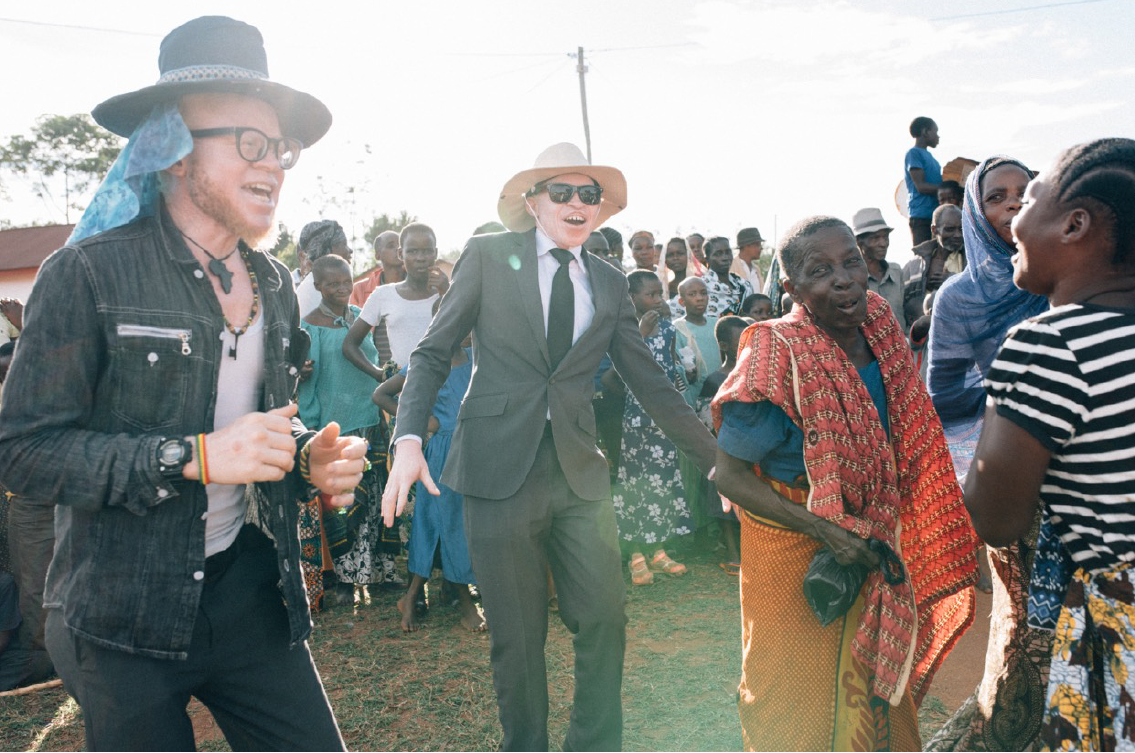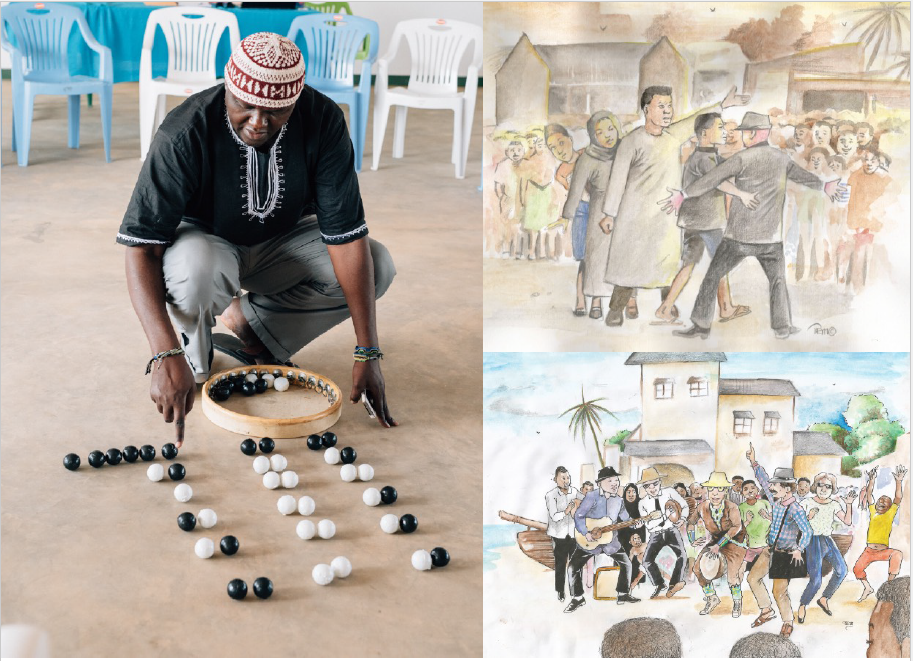Image: Standing Voice.
Standing Voice is an organisation that works to support people with albinism in Tanzania. This article explores how one of their projects, which communicates facts about albinism through interactive performances, navigates the cultural complexity surrounding albinism in Tanzania.
How can science, art, community come together to change lives?
Video: Project Overview from Standing Voice on Vimeo.
Cultural Complexity
Albinism is surrounded by myth and misconception in Tanzania and, as a result, those with albinism suffer abuse and discrimination. In ten years, there have been 76 reported murders of persons with albinism, 72 survivors of attacks, one abduction, and 21 grave violations in Tanzania. Yet no specific legislation targeting the protection of persons with albinism exists.
These attacks are largely the result of ignorance about the cause of albinism. Albinism is associated with witchcraft in Tanzania and it is believed that to have a child with albinism is a sign of a wrong doing in that child's ancestral line. It is also believed that taking a body part of someone with albinism to a witchdoctor will generate wealth for you and your family. This has led to mutilations and grave robberies. These beliefs must be confronted sensitively, and replaced with facts about albinism, if those living with the condition are to lead a fair life.
Aside from discrimination and violence, people with albinism are also at risk of health issues with a 23% presentation of skin cancer amongst people with albinism in some locations of Tanzania, plus issues with vision and a much lower life expectancy than average.
The Project
Bringing together scientists and artists from across the UK and Africa, this project explored the biomedical facts of albinism and the best strategies for communicating these to the Tanzanian public through interactive cultural forms. The project used indigenous cultural practices to spark public dialogue around science.
The project consisted of four phases:
1. Training and workshops
The workshops brought together scientists and artists to generate ideas for interactive performances about the genetic origins of albinism. The workshops introduced concepts of genetic inheritance to the project team, and explored narrative options to convey this information in a way that invites audience response. The team then tested the performance in Bagamoyo fish market, in order to practice delivering a spontaneous community performance and test the overall approach.
2. Delivery of comprehensive interactive narrative
The delivery of the interactive narrative took the form of spontaneous performances. The performances typically began with a scene that appeared real, in order to attract audiences and invite audience participation. This method proved highly effective in eliciting community engagement and response. The narrative used in each performance charted the life of a man with albinism wishing to have a relationship with a black woman, and the rejection of that man by the woman’s father. The team worked to ensure the narrative conveyed genetic inheritance and the concept of chance in a comprehensible way, e.g. through a ‘game of chance’ where black and white balls representing genes were juggled to illustrate the genetics of albinism.
Image: Standing Voice.
3. Further development for scale-up
The project team then trained community members in performance-based public engagement. People with albinism, and their friends and families, became the deliverers of engagement using their own experiences as foundations for performance development. This helped to produce a trail of change-makers across the region.
4. Production of filmed and audio-recorded outputs for dissemination
The team produced drawings, short films, songs, audio recordings, and photographs that all explore the genetic origins of albinism.
Key Findings
Standing Voice’s project evaluation found that the team successfully engaged civil society in a dialogue grounded in scientific fact, that challenged and changed damaging stereotypes and stigma surrounding albinism. It was also revealed that the concept of ‘chance’ inheritance was key to reshaping perspectives on albinism, as was the knowledge that one can ‘carry’ albinism genetically without having the condition oneself.
“Before this workshop I was very afraid of albino people … in this project I have learned that albinism comes by chance” (Interview with Daines Mwangamila)
It appeared to be the dialogue around scientific fact that prompted this transformation in attitudes. The project evaluation saw a clear difference between audiences’ responses before and after explorations of genetics.
“[I have learnt] we mustn’t ostracise albinos, we should protect them. We shouldn’t call them names” (Interview with Jenson Safina on Ukerewe following performance)
“Albinism occurs as a result of [melanin] deficiency” (Interview with girl following Ukerewe performance)
Image: Training and Rehearsal from Standing Voice on Vimeo.
The project team also demonstrated knowledge acquisition both on the subject of albinism itself and the strategy of public engagement. The approach (using dialogue to challenge and change damaging stigma around albinism) has also been replicated by partners. For example, musicians from across East Africa were connected and trained in advocacy, and they have since collaborated on advocacy-oriented music projects.
The project received a high level of online engagement through their disseminated creative outputs, with a total of 780 engagements (33,445 impressions) across their digital platforms.
Click here to read more about the project’s outcomes, evaluation, and theory of change.
Key Challenges
-
Certain parts of the narrative were difficult to construct, and this was where the team’s expertise was essential. The team worked to ensure the narrative conveyed genetic inheritance and the concept of chance in a comprehensible way.
-
The dissemination process identified emergent challenges, especially in the scale-up of the pilot. For example, adapting outputs for television would manifest new challenges relating to the immediacy of engagement and promotion of participatory dialogue with audiences.
-
Another limitation identified was the challenge of channelling responses from a global audience into creative outputs on the ground in Tanzania. Future scale-up (see below) would incorporate online responses more tangibly.
Looking Forward
Two areas for development were identified for future scale-up of the project:
-
Working to overcome the new challenges presented by global audiences (esp. online) who responded to the project in hindsight and after the moment for creative dialogue had passed.
-
Developing processes for selecting implementation locations through consultation with partner organisations (e.g. albinism associations) and flexibly reacting to evolving contexts.
---
“The feedback from the communities we engaged with was positive both in Bagamoyo and Ukerewe…They appeared to understand our message clearly. I think the combination of science and art that we employed was essential in making our points easily understood’. (Melkiades Banyanka)
Click here to read about the project in full [PDF].
Click here for more videos of the project (Vimeo).
Click here to visit the Standing Voice website.
This work is licensed under a Creative Commons Attribution 4.0 International License.




Please Sign in (or Register) to view further.